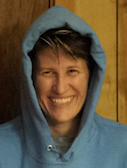Have You Fallen Down a Rabbit-Hole, or Could This Be Your Creative Spiral?
You did it, and whatever your “it” is, you find yourself feeling like you are falling or have fallen down the rabbit-hole in Alice’s Adventures in Wonderland.
Chances are, if you are here on Puttylike, your “it” is plural, and you’ve got multiple projects going. As a result of having so many interests, you might have someone, or several someones, coming at you with the sentiment of the Queen of Hearts: “Off with your head!” – or perhaps something a little less harsh, but equally stressful, possibly along the lines of, “Why are you doing that?” “What about your other project(s)?” “When will you decide what you want to do with your life?”
And there you are, feeling a bit like Alice, having instinctively chased the white rabbit down the rabbit-hole, and feeling yourself falling a long way down, past cupboards and book-shelves, possibly with maps and pictures and an empty jar of orange marmalade.
That falling sensation, a sense of being out of control, and seeing so many options available to you can be a scary feeling, and a common one for those of us with multiple career paths, many interests, and lots of projects underway at one time. But wherever you are in your own version of the rabbit-hole scenario, now is the time to get excited; your journey has begun!
The Creative Spiral
One of the points that sticks with me from photography school is that the creative journey is not a straight path, but rather a spiral. At first when I read this in my course materials, I didn’t think much of it. (I probably muttered to myself, “Here we go again, more art school mumbo jumbo.”) However, as I learned more about the spiral, it began to make sense. The premise is that there are themes, interests, and/or obsessions in life, and that we keep circling back to these same areas, even as we move farther and farther away from our starting point and continue to grow.
As someone who grew up with diverse interests, I had not thought of my life like this, but the more I analyzed where I had been, where I was then, and where I was interested in going, it made sense. In fact, the image of a spiral helped me to make connections and identify trends in my work. Instead of feeling caught in the flow of multiple projects and interests as if in a free fall, I could see my life moving in a spiral pattern. Even as some areas had begun to seem distant from the center, I could begin to see that everything was connected.
The spiral is an ancient symbol, dating back to pre-historic times. It has been found on works of art around the world. In Egyptian hieroglyphics, the spiral is one of four symbols for creation. It occurs in nature in plants and animals. One of my favorites has always been the nautilus shell, but you can see it all around, even in the patterns in which leaves grow on twigs or in the patterns of pine cones.
“[The spiral] stands for the repetitive rhythm of life, the cyclical nature of evolution and the permanence of being beneath the flux of movement.”
– Jean Chevalier and Alain Gheerbrant in A Dictionary of Symbols
Dr. Carl Jung likens the process of combining an old order with a new creation to “an ascending spiral, which grows upward while simultaneously returning again and again to the same point” and states that “what restores the old order simultaneously involves some new element of creation” and “[in] the new order the older pattern returns on a higher level.” I love the idea of growing and yet returning to the same points again and again, but on higher levels.
How Do You Learn More about Your Own Spiral?
This is the exciting part. We go back to Alice when the Caterpillar asks her, “Who are YOU?”
This is a difficult question for many of us, I know, but here’s how the creative spiral can help. Just follow these steps:
Name some themes in your own interests, projects, academic pursuits, obsessions, beliefs, and activities.
If step one stumps you, go through digital and physical files of your works and start listing themes, subjects, titles, projects, and favorites. Even if you aren’t stumped by step one, this approach will probably give you some more ideas.
Draw a spiral or a mind map of your results from the first two steps, or, if you prefer, write about it. At the very least, sit and think about your results. Personally, I find that the physical acts of writing and drawing help me to make connections.
If the Caterpillar were to ask you, “Who are YOU?” would you have a better idea? Try framing it like this:
“I am someone who likes ___________, who keeps returning to themes of ___________, and who is obsessed with___________.”
Further questions you might ask yourself include:
How will I circle back to these themes again?
Does what I am planning to do next relate at all to these themes?
How does looking at my spiral inspire me for future projects?
Adopting Alice’s Optimism
As we spiral our way through this blog entry back to Alice, I hope you can begin to adopt her optimism:
“so many out-of-the-way things had happened lately, that Alice had begun to think that very few things indeed were really impossible.”
I hope this exercise has helped you identify and clarify your spiral of diverse interests. Remember, you are at the center of all of them. You are the common factor. When faced with people who don’t get what you do, remember Alice’s response to the Queen’s, “Off with her head!”:
“Who cares for you?” said Alice […] “You’re nothing but a pack of cards!”
While it might be difficult for others to pigeon-hole you in a nice neat career title, it is more important that you know about yourself and your process. The more self-knowledge you have, the easier it will be to explain to the outside world, should you choose to do so. More importantly, knowing about your own spiral will help you make connections in your own life’s works and inspire continuing growth.
Your Turn
What does your spiral look like? Where do your current interests lie on your spiral?
 Dr. Brenda Scott is a fine art photographer, writer, and cellist. Originally trained as a musician and organologist, she has worked as a curator of a small musical instrument museum and her Stagville: Black & White exhibit has been displayed at the North Carolina Museum of History and is currently on tour. She enjoys teaching and holds degrees from the University of Oxford, the University of North Carolina at Chapel Hill, Auburn University, and the Academy of Art University. View her work at brendascottarts.com or follow her on Twitter @brendascottarts.
Dr. Brenda Scott is a fine art photographer, writer, and cellist. Originally trained as a musician and organologist, she has worked as a curator of a small musical instrument museum and her Stagville: Black & White exhibit has been displayed at the North Carolina Museum of History and is currently on tour. She enjoys teaching and holds degrees from the University of Oxford, the University of North Carolina at Chapel Hill, Auburn University, and the Academy of Art University. View her work at brendascottarts.com or follow her on Twitter @brendascottarts.



